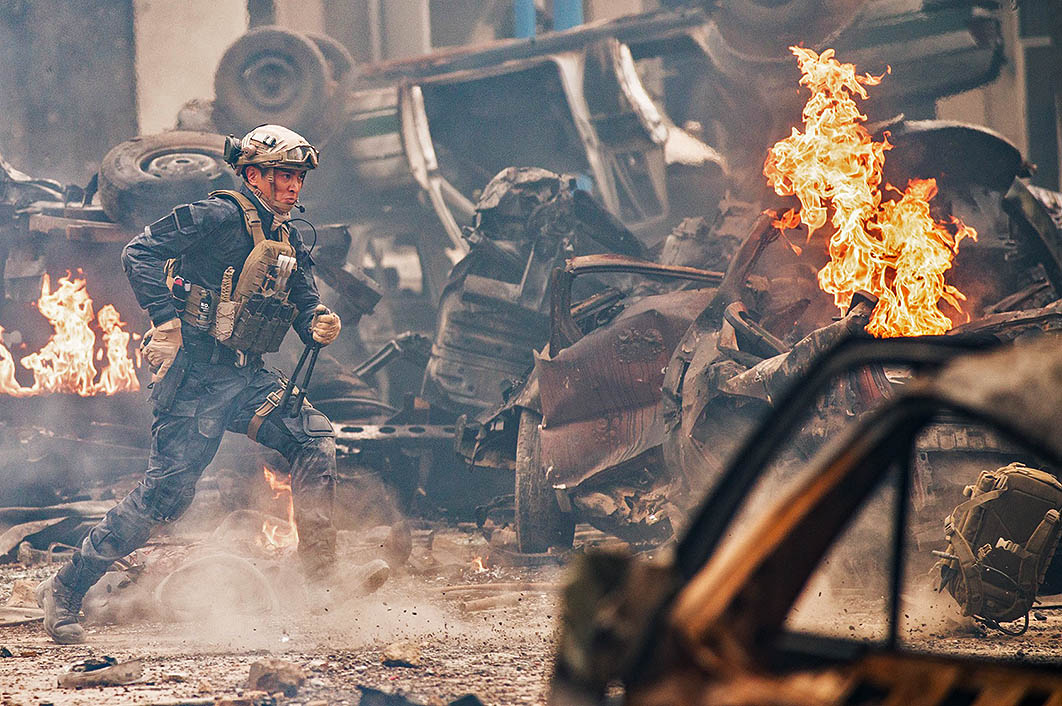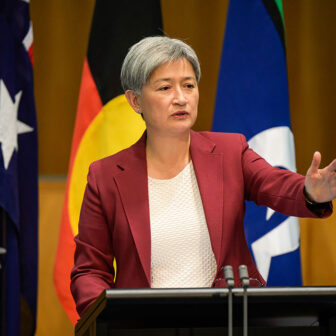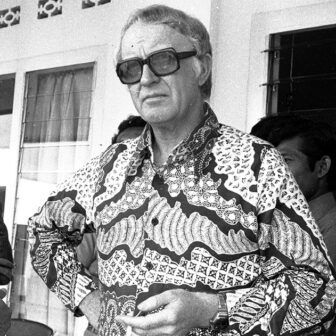It has all the elements you expect in an action movie. The elite special forces team with the hardnosed captain, the laconic demolitions expert, the crack sniper, the GI Jane — as tough as her male counterparts in hand-to-hand combat — and the young kid who has to step up and save the day. The enemy, of course, is a bunch of merciless jihadists bent on stealing nuclear material for a dirty bomb, under cover of a military coup. The heroine, an intrepid journalist, must divert the commandos from their rescue mission, to halt the theft of the radioactive stockpile.
But look out Hollywood, move over Bollywood. Operation Red Sea comes from China and is the latest in a series of blockbusters that combine explosive special effects with classic Hollywood clichés and propaganda motifs from the People’s Republic. Directed by Hong Kong film-maker Dante Lam, it is China’s second-highest-grossing movie of all time, raking in US$551 million in foreign sales during the five weeks after its release last month.
It’s a mixture of Black Hawk Down, Die Hard and The Perils of Pauline. Elite Chinese navy commandos are deployed to the fictional North African country of Yewaire to rescue Chinese citizens trapped between government and rebel forces in the middle of a coup d’état. During the operation, a beautiful French-Chinese journalist persuades the commandos to go beyond their mission and take down a group of Islamists who are fleeing with stolen radioactive materials. Many bangs and much bloodshed ensue as our eight heroes take on a stream of bad guys.
Zhang Yi stars as Yang Rui, the leader of the Jiaolong Assault Team (in real life, an elite Special Forces unit of the Chinese navy). Hai Qing, who was named the first UN Women national ambassador for China in 2015, plays the journalist who must persuade the tough-as-guts marines to disobey orders and save the day. It’s all great fun if you like gunfire, explosions and non-stop twists and turns.
The real significance of the film, however, lies in its propaganda value for the Chinese navy. Operation Red Sea was inspired by the 2015 evacuation of nearly 600 Chinese citizens from Aden during Yemen’s civil war, one of a series of similar recent deployments by Chinese forces.
This new kind of intervention was triggered by the deaths of Chinese civilians in Pakistan and Afghanistan in 2004. China’s president at the time, Hu Jintao, issued new guidelines on “diplomacy serving the people” (waijiao weimin), which required the military to protect Chinese nationals overseas. The policy faced its first real tests in 2006, when Chinese nationals were caught up in riots and disturbances across the Pacific. In April, China evacuated 310 nationals from Honiara after anti-Chinese rioting following the Solomon Islands elections. Later that month, another 243 Chinese were evacuated from Timor, fleeing armed clashes in the capital, Dili. In November, another 193 Chinese were flown out of Nuku’alofa after riots destroyed a number of Chinese and local businesses in the Tongan capital. Chinese small-business owners and workers from state-owned corporations were also targeted in anti-Asian rioting in Papua New Guinea in May 2009.
These responses were part of a global trend. China is becoming more internationally engaged under Xi Jinping’s Belt and Road Initiative and the expanded reach of Chinese state-owned and private corporations. According to the latest data, more than five million Chinese passport holders — diplomats, tourists, construction workers, development technicians and others — now live outside China, especially in the developing world. It’s hardly surprising that significant numbers of them face hazards.
The Stockholm International Peace Research Institute has documented a range of Chinese interventions to protect civilians over the last fifteen years, including evacuations from Chad and Thailand in 2008, Haiti and Kyrgyzstan in 2010, and Egypt and Syria in 2011 during the Arab Spring. These evacuations generally use civilian aircraft and vessels, but the People’s Liberation Army, or PLA, has also weighed in with military hardware. The Jiaolong Special Forces were first in the public eye during a 2008 mission to accompany three Chinese warships protecting commercial ships from Somali pirates as part of a UN mandate. Since then, they’ve been more active.
The PLA’s largest deployment was part of the evacuation of more than 35,800 Chinese citizens from Libya in March 2011. The operation involved civilian planes as well as the PLA Jiangkai-II class frigate Xuzhou and four PLA air force Ilyushin transport aircraft sent to Sabha in southern Libya. In March 2015, as the Yemen crisis escalated, 563 Chinese citizens and 233 foreign nationals from thirteen countries were evacuated to Djibouti by the PLA navy. In a region where the Belt and Road Initiative is expanding, China is constructing a naval logistics base in Djibouti, alongside existing military facilities used by the United States, France and Japan.
Given Beijing’s responsibility to protect the growing Chinese diaspora in Oceania, it’s possible that we’ll see more interventions by Chinese forces in the South Pacific. It’s a trend worrying Australian defence planners and politicians, who see the Pacific islands as “our patch” and are wary of the influence of “non-traditional” partners.
Until now, Chinese nationals have been evacuated from the Pacific in civilian aircraft. But some Australian defence analysts are anxious about wider strategic implications, fearing that the PLA’s growing role in “overseas citizen protection” will be used to deploy Chinese military forces in the South Pacific. In this light, films like Operation Red Sea are seen as part of a broader propaganda effort, supporting a strategic plan by the Chinese government to justify military deployments into the Indian and Pacific Oceans.
“Given the potential for anti-Chinese riots in the South Pacific, the requirement for Chinese ‘overseas citizen protection’ may become a reality in Melanesia in the near future,” argues Colonel Peter Connolly, director for international engagement with the Australian army. “In a hypothetical development where a PLA amphibious element arrives to protect evacuees in Papua New Guinea alongside the contingents from Australia and other traditional regional partners, there is scope for accidental friction leading to tension and suspicion of intent.”
There is a certain irony in Colonel Connolly’s concern — indeed, the words “pot” and “kettle” spring to mind. The Australian Defence Force, or ADF, has long deployed military forces to the Pacific in times of crisis, using the evacuation of Australian civilians as justification.
In May 1987, Operation Morris Dance saw the first operational deployment of an Australian infantry unit since the Vietnam war, in response to Sitiveni Rabuka’s coup in Fiji. During Operation Plumbob in June 2000, as conflict escalated between rival militias in the Solomon Islands capital, Honiara, HMAS Tobruk was used to evacuate 426 Australian nationals.
But perhaps the most noteworthy intervention took place between October and December 2006. The ADF deployed SAS troops and three warships off the coast of Fiji as tensions grew between the government of Fiji and the Republic of Fiji Military Forces, or RFMF, led by Commodore Voreqe Bainimarama — a political crisis that culminated in a military coup on 5 December.
The intervention, Operation Quickstep, ended in tragedy when a Blackhawk helicopter carrying the SAS troops crashed during a landing on HMAS Kanimbla, causing two deaths. Commenting on the board of inquiry report into the crash in 2008, Air Chief Marshal Angus Houston noted the helicopter was participating in training that “involved performing special operations assaults.” The aim of the assaults, he wrote, “was to deliver Special Forces troops on to a specific target area quickly and at the first attempt in order to maximise surprise and minimise exposure to threat.”
On 29 November, RFMF troops in full battle gear had secured strategic sites, including the Telecom headquarters, Fiji Electricity Authority and government offices, and soldiers had set up roadblocks around the capital, Suva, and fired illumination rounds into the sea. A week later, Commodore Bainimarama seized power. Ironically, some observers in Suva felt that the RFMF used the Australian naval and SAS deployment as an excuse to move forward the date of the coup.
Given past problems with logistic capacity, the Australian government has recently launched HMAS Canberra and HMAS Adelaide, two Canberra-class landing helicopter dock vessels, which can carry troops and helicopters for amphibious assaults. But with China now serving as Fiji’s largest aid donor, the next naval deployment to Suva harbour may not involve the ADF at all. ●




